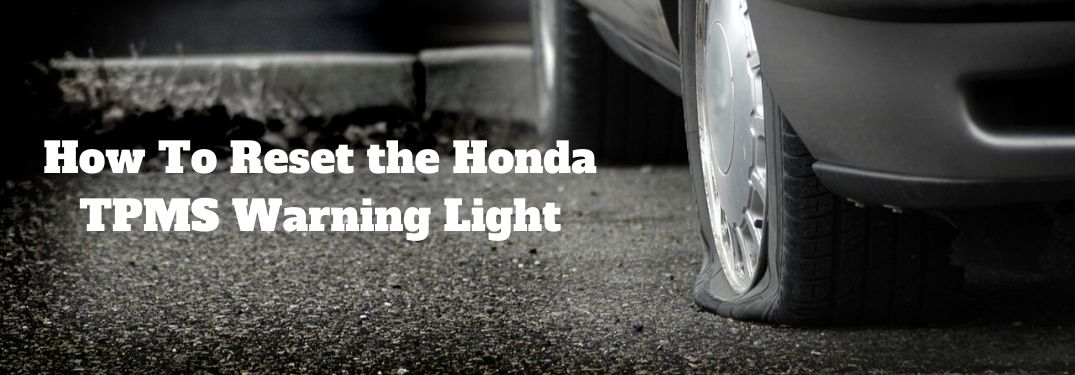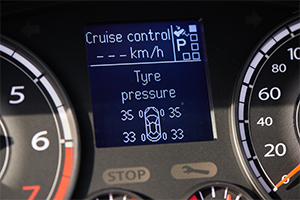
Your Tire Pressure Monitoring System is a valuable tool, but only if you pay attention when the Honda TPMS Warning Light comes on. When the tire light alerts you to low tire pressure – you will need to address the problem and reset the light.
Please remember that the tire pressure sensors are not a substitute for checking your tire pressure regularly. It won’t light up unless the problem is becoming serious. Underinflated tires can be a safety hazard.
Troubleshooting the Tire Pressure Monitoring System
Here’s some good information that may answer some of your questions about TPMS and your tire warning light. Please be aware that Honda Tire Pressure Monitoring Systems vary, depending on the model type and model year. Furthermore, TPMS systems are not uniform across the spectrum of car brands.
In addition, the technology changes from time to time, meaning that older models may not have the same capability found on new ones. If in doubt, please contact your Earnhardt service advisor.

When Does the TPMS Light Come On?
The tire pressure light isn’t required to come on until the tire is 25 percent below recommendations. Therefore, you should never ignore it. The manufacturer’s recommended air pressure is in your owner s manual.
What if the TPMS Light Came On For a Few Minutes and Turned Itself Off?
The most likely trigger is cold. Tire pressure drops about 1 psi with every ten degree drop in cold weather. As your tires heat up, the pressure stabilizes. That’s why there are winter and summer standards for properly inflated tires. However, with our Phoenix AZ climate, an inaccurate TPMS light should be reported to your Earnhardt Honda service center to make sure it is operating accurately.
What if I filled the tire, but the sensor didn’t reset?
Try driving the vehicle at over 28 miles per hour for a few minutes. At that speed, the TPMS will get little or less interference from other sensors and radio frequencies. This allows it to update through the serial data bus, sending the proper tire information to the TPMS sensor. If it never resets, talk to an expert at your Earnhardt Honda service center to find out why.
What if I reset the TPMS light, but now it’s flashing?
According to the National Highway Traffic Safety Administration, systems may flash or stay on longer to indicate a problem with the TPMS system rather than the tire. After checking that your tires have the proper pressure, you may need a mechanic to read the code and tell you what’s happening.
Does TPMS Read my Spare Tire?
The spare tire does not have a sensor for the TPMS system to read. The system may register nothing where the tire should be. As long as you are confident that the spare has the correct tire pressure, it should not represent a problem.

Why Can’t I See That My Tire is Low?
Unfortunately, human eyesight cannot detect that a tire is low until the problem is really severe. Your manufacturer’s recommended pressure is in your owner s manual.
Can I Disconnect the Battery to Clear the TPMS Sensor?
Some people try to clear codes by disconnecting the battery. Generally the system saves all codes and doesn’t reset them just because the battery is removed. This is actually a fail-safe feature because mechanics need those codes to determine what is wrong with a vehicle.
What if I clear the code before my mechanic has a chance to read it?
If you are able to clear the TPMS code, you will be overwriting it with a new code. Unless the system triggers the sensor again, your mechanic will not find the important code. So it is best not to clear codes until a highly qualified Honda mechanic has a chance to determine what’s happening.
Why is Tire Pressure So Important?
According to the automotive journalists at Edmunds, a mere 5 PSI can cause a tire to fail. An underinflated tire generates heat as it struggles to keep up with the job it has to do. This causes faster degeneration.
Furthermore, an underinflated tire affects the accuracy of steering and handling. Thus, the vehicle declines in performance and fuel economy. If a tire blows, it can lead you to have a one-car accident. Even worse, it could be a multi-car accident if you are in busy traffic.
What is Direct vs. Indirect TPMS?
Direct TPM sensors are attached to the valve for the most accurate reading. With indirect TPMS, the anti-lock brake system assists in determining approximate pressure. Although a good system, it is not as fast as a direct system.
Does My Old Car NOT Have Tire Pressure Monitoring?
Starting with the 2008 model year, every Honda has TPMS. All cars made before the 2018 probably don’t have this feature.
If you don’t have a light to turn on and warn you, it’s all the more important to carry a gauge to check and add air as needed. Explore the Earnhardt Honda inventory today to find a new or certified preowned Honda car, truck or crossover with TPMS!
How To Reset the Honda Tire Pressure Monitoring System TPMS Warning Light
Learn how to reset the tire warning light with this step-by-step guide and get back to normal. Instructions To Reset the Honda TPMS Warning Light
- Check the Tire Pressure in All Tires
- Fill With Air or Replace Tires as Needed
- Keep Your Honda in Park and Start the Vehicle
- Find the Honda TPMS Button to the Left of the Steering Column
- Press and Hold Until the TPMS Warning Light Blinks Twice
- Honda TPMS Will Begin to Re-Calibrate
- If There is No TPMS Button – Select Vehicle Settings on the MID Screen
- Press the Select/Reset Button
- Select TPMS Calibration
- Select Calibrate




